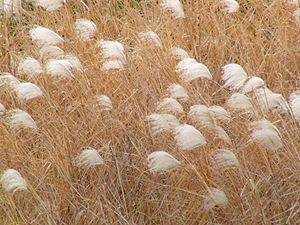- Miscanthus sacchariflorus
-
Miscanthus sacchariflorus Miscanthus sacchariflorus
Systematik Commeliniden Ordnung: Süßgrasartige (Poales) Familie: Süßgräser (Poaceae) Unterfamilie: Panicoideae Gattung: Miscanthus Art: Miscanthus sacchariflorus Wissenschaftlicher Name Miscanthus sacchariflorus (Maxim.) Hack. Miscanthus sacchariflorus ist eine Grasart aus der Familie der Süßgräser (Poaceae). Die in Ostasien heimische Pflanze ist eine der Elternarten der Energiepflanze Riesen-Chinaschilf (Miscanthus × giganteus).
Inhaltsverzeichnis
Merkmale
Miscanthus sacchariflorus ist eine ausdauernde Pflanze und bildet lange, schlanke Rhizome, die mit kurzen, kahlen bis behaarten Cataphyllen besetzt sind. Die Halme sind schlank, aufrecht, 65 bis 160 cm hoch, nicht hohl und unverzweigt. Die Blätter stehen am Halm. Die Blattscheiden sind gerieft und kahl. Die Blattspreiten sind linealisch, flach, 20 bis 50 cm lang und 0,5 bis 1,5 cm breit. Sie sind kahl, haben eine deutliche Mittelrippe und enden zugespitzt. Das Blatthäutchen ist rund 5 mm lang und trägt 1 bis 2 mm lange Wimpern.
Der Blütenstand ist eine 7 bis 30 cm lange Rispe, deren Hauptachse 5 bis 15 cm lang, kahl oder an der Basis behaart ist. Die vier bis 24 traubigen Teilblütenstände sind 5 bis 20 cm lang. Die Internodien der Rachis sind kahl, die Knoten kahl oder behaart. Die Ährchen sind 4 bis 6 mm lang, behaart und unbegrannt. Am Callus sitzen 8 bis 12 mm lange Haare, die aus dem Ährchen ragen. Die Hüllspelzen sind ungleichartig, häutig, 4 bis 6 mm lang, mit undeutlichen Nerven und am Ende zugespitzt. Die untere Hüllspelze ist dich behaart mit langen Haaren an den Rändern. Die obere ist nur an der Spitze kurz behaart. Die Deckspelzen sind lanzettlich, hyalin und rund 3 mm lang. Sie haben 0 bis 1 Nerv, Spitze und Ränder sind behaart. Die Vorspelze ist als eine kleine, nervenlose, behaarte Schuppe ausgebildet. Die drei Staubbeutel sind 2 bis 2,5 mm lang. Die Karyopse ist länglich.
Verbreitung und Standorte
Miscanthus sacchariflorus kommt in China (Gansu, Hebei, Henan, Shaanxi), in Japan, Korea und im Osten Russlands vor. Sie wächst an Berghängen und an Flussufern.
Belege
- Chen Shouliang, Stephen A. Renvoize: Miscanthus Andersson, Öfvers. Kongl. Vetensk.-Akad. Förh. 12: 165. 1855, Flora of China, Band 22, 2006, S. 581–583. (Online)
Weblinks
-
 Commons: Miscanthus sacchariflorus – Sammlung von Bildern, Videos und Audiodateien
Commons: Miscanthus sacchariflorus – Sammlung von Bildern, Videos und Audiodateien
Wikimedia Foundation.

